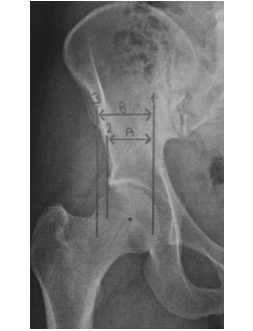Objective: The aim of this study was to investigate whether being the parents of children with developmental hip dysplasia (DDH) is a risk factor for asymptomatic dysplasia.
Methods: Asymptomatic parents of children who were diagnosed with DDH were assessed for presence of dysplasia by examining their anteroposterior pelvis radiographs at the neutral position. Eighty-six hips of 43 participants were included in the study group and 98 hips of 49 participants were included in the control group. Presence of hip dysplasia over the anteroposterior pelvis radiographs was analyzed for Wiberg's angle, acetabular index of the weight-bearing zone (the Tonnis angle), acetabular depth/width € index, femoral head coverage ratio (FHCR) and femoral neck/shaft angle.
Results: The mean acetabular depth/width ratio was 44.3% in the study group and 53.5% in the control group. And, the mean FHCR was 80% in the study group and 82% in the control group. There was a statistically significant difference between the two groups in terms of mean acetabular depth/width ratio (p < 0.05) and FHCR (p < 0.05). In addition, 21 participants in the study group and 2 in the control group had a pathological acetabular depth/width ratio. And, the number of participants with a pathological FHCR was 22 in the study group and 13 in the control group. A statistically significant difference was found between the two groups regarding the number of pathological measurements of acetabular depth/ width ratio (p < 0.05) and FHCR (p < 0.05).
Conclusion: Having a parent with DDH is a definitive risk factor for the development of hip dysplasia in childhood. In addition, being a parent of a child with DDH is a risk factor for asymptomatic dysplasia. These parents should be screened by roentgenogram.
Level of Evidence: Level III, Diagnostic Study.



.png)
.png)

